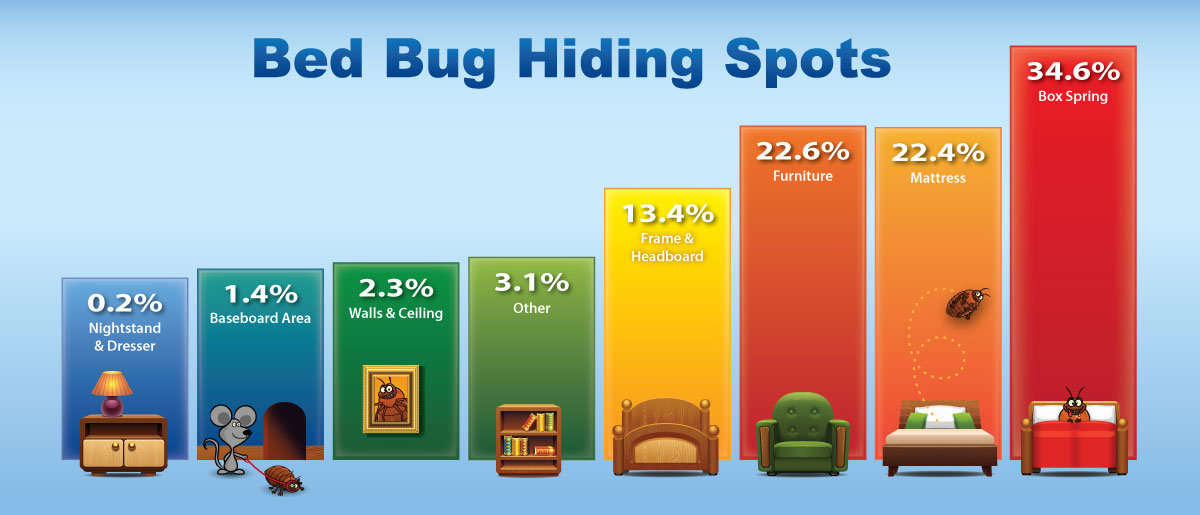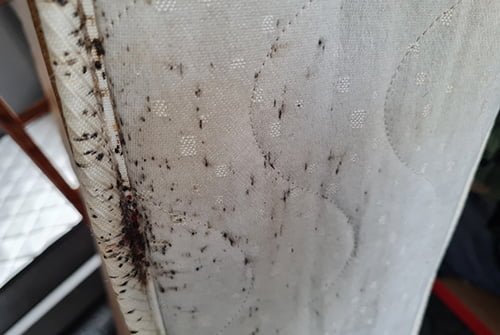To hide from bed bugs, use mattress encasements and regularly inspect bedding for signs of infestation. Preventive measures are key to avoiding bed bug encounters.
Bed bugs can cause anxiety and discomfort with their presence, so it’s essential to take steps to protect yourself and your space. By being proactive and maintaining cleanliness, you can reduce the risk of a bed bug infestation. Understanding their behavior and habits will help you create a plan to avoid encounters and keep your home bug-free.
Remember, prevention is always better than dealing with an infestation later on. Stay vigilant and take the necessary precautions to stay free from bed bugs.
Identifying Bed Bugs
Knowing how to identify bed bugs is essential in order to effectively hide from them. These tiny creatures can infest your home and cause numerous problems if not detected early. In this section, we’ll discuss the physical characteristics of bed bugs and their common hiding spots.
Physical Characteristics
Bed bugs are small oval insects with flat bodies that measure between 4 to 5 millimeters in length. They are typically reddish-brown in color, although their shade can vary depending on whether they have fed recently or not. Bed bugs have six legs and two antennae, allowing them to move quickly and locate potential hosts.
One noticeable feature of bed bugs is their ability to crawl into tight spaces, thanks to their flat bodies. This makes them adept at hiding in cracks, crevices, and even electrical outlets, making them difficult to spot.
Common Hiding Spots
Bed bugs tend to hide in places that provide easy access to their preferred food source – human blood. The following are some of their favored hiding spots:
| Hiding Spot | Reasoning |
|---|---|
| Mattresses and Box Springs | Proximity to potential hosts and availability of hiding spots within seams and crevices |
| Bed Frames and Headboards | Easy access to beds and hiding spots provided by joints and cracks |
| Furniture and Upholstered Items | Ample hiding spots within cushions, seams, and gaps |
| Cracks and Crevices in Walls | Provide dark and undisturbed environments |
| Electrical Outlets | Small size allows them to squeeze into outlets |
It’s important to note that bed bugs can also be found in other areas, such as behind wallpaper, in luggage, and even inside clothing. By being aware of their preferred hiding spots, you increase your chances of detecting and addressing an infestation early on.
Prevention Methods
Protective Covers
Use protective covers on mattresses and box springs to prevent bed bugs from infesting these areas.
Clutter Reduction
Keep your living space neat and organized by reducing clutter to eliminate potential hiding spots for bed bugs.
Laundry Practices
Regularly wash and dry bedding, linens, and clothing at high temperatures to kill any bed bugs or eggs present.
Natural Remedies
When dealing with bed bugs, natural remedies can be an effective way to keep them at bay. Here are some natural methods you can use to hide from bed bugs:
Essential Oils
Essential oils like lavender and tea tree are natural bed bug repellents.
Diatomaceous Earth
Diatomaceous Earth is a fine powder that can be sprinkled around your bed to deter bed bugs.
| Essential Oils | Diatomaceous Earth |
|---|---|
| Lavender oil | Effective powder |
| Tea tree oil | Physical barrier |
- Essential oils can repel bed bugs naturally.
- Diatomaceous Earth acts as a barrier against bed bugs.
Professional Treatment Options
When it comes to eliminating bed bugs from your home, professional treatment options are often the most effective and efficient solution. These options employ advanced techniques and technologies specifically designed to target and exterminate bed bugs, ensuring your space is free from these pesky pests.
Extermination services offered by professionals are a popular choice for battling bed bugs. These services involve meticulous inspections, customized treatment plans, and a combination of different extermination methods to eliminate the infestation completely.
Here are some common extermination methods:
1. Pesticide Treatment:
- This method involves the use of specially formulated insecticides to eliminate bed bugs. Professionals apply these pesticides to infested areas, such as cracks, crevices, and furniture, to eradicate the bed bug population.
2. Vacuuming and Steam Treatment:
- Vacuuming and steam treatment are effective methods for removing bed bugs and their eggs from furniture, mattresses, and carpets. These processes utilize high-pressure steam to kill bed bugs and a vacuum to eliminate their remains.
3. Freezing and Cold Treatment:
- Freezing and cold treatment involve exposing infested items to extremely low temperatures to kill bed bugs. This technique can be utilized for smaller items, such as clothing, bedding, and electronics.
Heat treatment is another professional option that has gained popularity due to its effectiveness in eradicating bed bugs. This method utilizes specialized equipment to raise the temperature of the infested area, rendering it inhospitable for bed bugs to survive.
Here’s how the heat treatment process typically works:
- Thorough Inspection: Professionals perform a detailed inspection to identify all the areas infested with bed bugs. This step ensures that the heat treatment targets all the hiding spots.
- Sealing and Preparation: Before the treatment, professionals seal off the area to prevent heat from escaping. They may also remove heat-sensitive items or advise you on how to protect them during the process.
- Heat Application: Specialized equipment, such as heaters and fans, are strategically placed throughout the space to gradually raise the temperature. The heat is evenly distributed to ensure all bed bugs and their eggs are exposed.
- Monitoring: Throughout the process, professionals carefully monitor the temperature to ensure it remains at lethal levels for the required duration. This guarantees the complete eradication of bed bugs.
- Post-Treatment Evaluation: After the heat treatment, experts may conduct a post-treatment evaluation to ensure all bed bugs have been eliminated. They may also provide you with prevention tips to avoid future infestations.
Professional heat treatment is a reliable option that eliminates bed bugs without the use of harsh chemicals or pesticides. It reaches even the hidden areas where bed bugs may be lurking, ensuring a thorough eradication.
Travel Considerations
When traveling, it’s essential to take steps to protect yourself from bed bugs and prevent bringing them back home. Here are some travel considerations to keep in mind to stay safe from these pesky pests.
Inspecting Hotel Rooms
Before settling into your hotel room, take a few minutes to inspect the surroundings for any signs of bed bugs. Check the mattress seams, headboard, and nearby furniture for dark spots, eggs, or live bugs. If you notice any evidence of bed bugs, request a new room far away from the infested one.
Luggage Maintenance
Keep your luggage off the floor and the bed to minimize the risk of bed bugs hitching a ride. Use a luggage rack or place your bags on a hard surface, like a dresser or table. Additionally, consider using bed bug-proof luggage encasements to provide an extra barrier of protection against these pests.

Credit: www.wikihow.com
Bite Management
Bite management is crucial when dealing with bed bug infestations. Ensuring relief from symptoms and seeking medical treatment can help mitigate the discomfort and potential health concerns associated with bed bug bites.
Symptom Relief
Immediate symptom relief can be achieved through various remedies that help alleviate itching, swelling, and discomfort caused by bed bug bites. It’s essential to cleanse the affected area with mild soap and water to prevent infection. Applying calamine lotion or over-the-counter hydrocortisone cream can help reduce itchiness and inflammation. Additionally, using a cold compress can provide relief from pain and swelling.
Medical Treatment
For severe reactions to bed bug bites, seeking medical attention is imperative. Physicians may prescribe antihistamines to alleviate itching and a mild corticosteroid cream to reduce inflammation. Severe cases may require prescription-strength corticosteroids to manage more intense symptoms. In some instances, oral antibiotics may be necessary to treat secondary skin infections resulting from scratching.
Understanding Bed Bug Behavior
Before you learn how to hide from bed bugs, it’s important to understand their behavior. Bed bugs are tiny, oval-shaped insects that thrive on the blood of humans and animals. They are primarily active at night and have a remarkable ability to hide in cracks and crevices throughout your home. By studying their behavior, you can take the necessary precautions to protect yourself and prevent bed bug infestations.
Nighttime Activity
Bed bugs are nocturnal creatures, which means they are most active during the night. They prefer to hide during the day in places like mattresses, box springs, bed frames, and even behind wallpaper or electrical outlets. At night, they come out to feed on their unsuspecting hosts, attracted by the carbon dioxide we exhale and the warmth of our bodies.
Feeding Patterns
When bed bugs feed, they use their elongated beak-like mouthparts to pierce the skin and extract blood. Although their bites are not painful, they can lead to itchy welts and allergic reactions in some individuals. Once they’ve finished feeding, bed bugs retreat to their hiding spots to digest their meal and mate. They can go up to several months without feeding, making them resilient and difficult to eliminate.
Understanding their feeding patterns is crucial in devising effective strategies to hide from bed bugs.
Here’s a closer look at their feeding patterns:
| Feeding Frequency | Feeding Duration | Feeding Locations |
|---|---|---|
| Every few days | 3-10 minutes per feeding | Exposed skin areas during sleep |
| Multiple bites per feeding session | Sometimes interrupted feeding if disturbed | Concentrated around the face, neck, arms, and legs |
To minimize the risk of getting bitten, you can focus on hiding exposed skin areas, such as wearing long-sleeved pajamas and socks. Additionally, you can use bed bug-proof mattress encasements and regularly inspect and vacuum your sleeping area.
By understanding their nocturnal activity and feeding patterns, you are better equipped to protect yourself and your home from these pesky insects.

Credit: www.orkin.com
Home Inspection
When it comes to protecting your home from bed bugs, starting with a thorough home inspection is crucial.
Routine Checks
Regularly conduct routine checks in your home to detect any bed bug activity early on.
Recognizing Signs
Familiarize yourself with the common signs of bed bugs to quickly identify any infestations.

Credit: mattresssafe.com
Frequently Asked Questions For How To Hide From Bed Bugs?
How Can I Prevent Bed Bugs From Entering My Home?
To prevent bed bugs, regularly inspect your home for signs of infestation. Use mattress covers and keep your home clutter-free. When traveling, inspect hotel rooms for signs of bed bugs, and wash and dry clothes on high heat to kill any potential hitchhikers.
What Are The Signs Of A Bed Bug Infestation?
Common signs of a bed bug infestation include small bloodstains on sheets, rusty or reddish stains on bed linens, and a sweet, musty odor. You may also notice small, itchy bites on your skin or see exoskeletons or live insects around your bedding or mattress.
How Can I Treat A Bed Bug Infestation?
To treat a bed bug infestation, thoroughly clean and vacuum infested areas. Use pesticides specifically designed for bed bugs and consider hiring a professional exterminator for severe infestations. Wash and heat-dry all clothing, bedding, and other infested items to eradicate bed bugs.
Can Bed Bugs Be Eliminated Without Using Pesticides?
Yes, bed bugs can be eliminated without using pesticides through non-toxic methods such as heat treatments, steam cleaning, or freezing. These methods effectively kill bed bugs and their eggs without the use of harmful chemicals. Consult with a professional pest control service for the best non-toxic treatment options.
Conclusion
To keep those blood-sucking critters at bay, take proactive steps like decluttering and vacuuming regularly, sealing cracks and crevices, and using protective covers for your mattress and box spring. Additionally, applying natural bed bug repellents and using traps can further help in preventing an infestation.
By following these simple yet effective methods, you can greatly reduce the chances of a bed bug encounter and enjoy a peaceful sleep. Stay informed, stay vigilant, and stay bed bug-free!
Related posts:

I’m MD Tanvir, and I bring years of expertise gained from working closely with pest control companies to the forefront. My journey in the industry has inspired me to launch Bug Battler, a platform aimed at equipping people with the know-how to combat pests autonomously. Through Bug Battler, I aim to empower individuals with practical insights to tackle pest infestations effectively.

